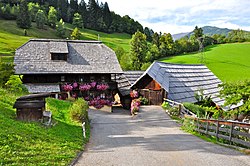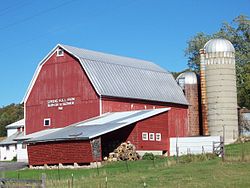
Back مزرعة عائلية Arabic Ailə-kəndli təsərrüfatı Azerbaijani Фамилна ферма Bulgarian کێڵگەی خێزانی CKB مزرعه خانوادگی Persian Ferme familiale French 가족 농장 Korean അന്താരാഷ്ട്ര കുടുംബകൃഷി വർഷം Malayalam Slektsgard NN Gospodarstwo rodzinne Polish



| Rural area |
|---|
A family farm is generally understood to be a farm owned and/or operated by a family.[3] It is sometimes considered to be an estate passed down by inheritance.
Although a recurring conceptual and archetypal distinction is that of a family farm as a smallholding versus corporate farming as large-scale agribusiness, that notion does not accurately describe the realities of farm ownership in many countries. Family farm businesses can take many forms, from smallholder farms to larger farms operated under intensive farming practices. In various countries, most farm families have structured their farm businesses as corporations (such as limited liability companies) or trusts, for liability, tax, and business purposes. Thus, the idea of a family farm as a unitary concept or definition does not easily translate across languages, cultures, or centuries, as there are substantial differences in agricultural traditions and histories between countries and between centuries within a country. For example, in U.S. agriculture, a family farm can be of any size, as long as the ownership is held within a family. A 2014 USDA report shows that family farms operate 90 percent of the nation's farmland, and account for 85 percent of the country's agricultural production value.[4] However, that does not at all imply that corporate farming is a small presence in U.S. agriculture; rather, it simply reflects the fact that many corporations are closely held. In contrast, in Brazilian agriculture, the official definition of a family farm (agricultura familiar) is limited to small farms worked primarily by members of a single family;[5] but again, this fact does not imply that corporate farming is a small presence in Brazilian agriculture; rather, it simply reflects the fact that large farms with many workers cannot be legally classified under the family farm label because that label is legally reserved for smallholdings in that country.
Farms that would not be considered family farms would be those operated as collectives, non-family corporations, or in other institutionalised forms. At least 500 million of the world's [estimated] 570 million farms are managed by families, making family farms predominant in global agriculture.[6][7]
- ^ Anton Schroll, Dehio-Handbuch. Die Kunstdenkmäler Österreichs. Kärnten, 2001, 660f.
- ^ Hans Stofer-Schröter, 250 Jahre Pachtverhältnis der Familie Stofer (1981); sold to Emmen cooperative in 1918. State Archive of Lucerne PA 407/89; now owned by the canton of Lucerne. Listed as Cultural Property of National and Regional Significance (admin.ch Archived 2015-07-12 at the Wayback Machine).
- ^ Kaddu, Sarah; Haumba Eric (2015). The Role of Community Libraries in Providing Quality Information to Family Farmers: A Case of Huege Community Library in Uganda. AfLIA. Archived from the original on 2020-06-02. Retrieved 2020-05-31.
- ^ "U.S. Farms, Large and Small | USDA". www.usda.gov. Retrieved 2018-04-13.
- ^ Farms are those that employ mostly family members, with a maximum of five additional temporary workers. Banco do Nordeste. "Agricultura familiar – apresentação" (in Portuguese). Archived from the original on 2 October 2009. Retrieved 30 September 2009.
- ^ "FAO - News Article: Putting family farmers first to eradicate hunger". Archived from the original on 2019-04-10. Retrieved 2015-04-16.
- ^ Lowder, S. K., J. Skoet and S. Singh. 2014. What do we really know about the number and distribution of farms and family farms worldwide? http://www.fao.org/docrep/019/i3729e/i3729e.pdf